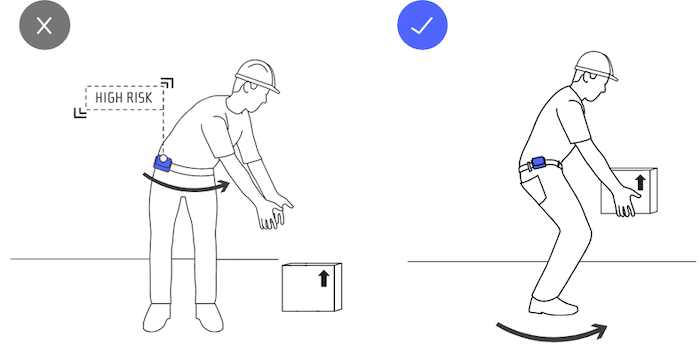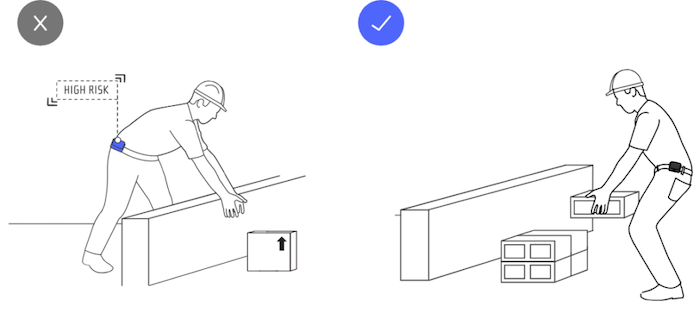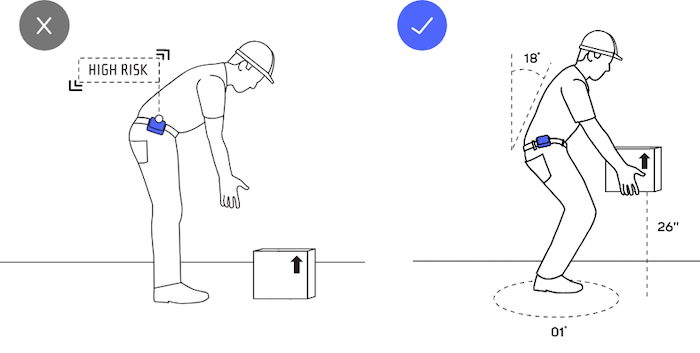Your role as a risk management partner is crucial in helping your clients protect their employees and their bottom line. One area of concern, especially with frontline employers, is the risk associated with improper lifting techniques. Back injuries resulting from lifting tasks can cause businesses to experience significant costs and productivity losses.
More than one million workers suffer back injuries each year, and back injuries account for one of every five workplace injuries or illnesses. – Bureau of Labor Statistics
The average cost of a worker’s comp back injury claim is between $40,000 and $80,000 per employer. – Occupational Safety and Health Administration
Understanding the Risks
On-the-job lifting and materials handling, whether it’s a core part of the job or an occasional task, pose inherent risks. Workers often suffer injuries when they don’t perform these tasks safely and properly. Back strain caused by overstretching muscles is the most common type of injury resulting from improper lifting. However, more severe injuries like damaged or herniated disks can also occur.
By implementing safe lifting techniques, the likelihood of these injuries can be significantly reduced.
Safe Lifting Tips
Encourage your clients to implement safe lifting techniques to help minimize the risk of back injuries among their frontline workforce. Here’s a safe lifting checklist employers can share with workers to help prevent injury.
- Size up the load: Before attempting to lift an object, assess its weight and size. If it’s too heavy or bulky to handle alone, ask for assistance. Collaboration reduces the risk of injury.
- Inspect your path: Examine the path you’ll be taking while carrying the load. Remove any obstacles or potential hazards that could impede your movement.
- Face the object: Place your feet so your toes and hips face the object you’re lifting to avoid twisting.

- Get as close as possible: Take a wide stance as close to, or over, the object to avoid overreaching and reduce the strain on your back.

- Bend at the knees: When preparing to lift, squat down by bending your knees, not at your waist. When you bend at the waist, the pressure on your back is 10 times the actual weight of the load! As you bend your knees, look straight ahead to keep your shoulders back and your spine appropriately arched.

- Engage your leg muscles: Your leg muscles are stronger and more durable than your back muscles. Push through your heels to generate the lifting force, keeping your back straight as you rise.
- Keep your feet flat on the floor: When you squat next to a heavy object and your heels come off the floor, you risk tipping over and putting more stress on your knees.
- Carry the load close: Carry the load as close to your body as possible, preferably near your waist. This improves stability and reduces strain on your back.
- Move your feet when changing directions: When changing direction while carrying a load, avoid twisting your upper body. Instead, pivot using your feet and take small steps.
- Reposition for overhead lifts: When lifting overhead set the object on a table or shelf and reposition it so your arms are doing the lifting. Use a ladder or step stool when possible.
- Maintain posture when setting objects back down: When you put the object down, take a wide stance, keep your feet flat on the ground, and bend your knees as you lower the object. You can go down to one knee to help “bridge” the weight as you set the object down.
How Wearables Support Safe Lifting
Wearable technology can automatically recognize high-risk movements commonly performed during on-the-job lifting, and provide employees with continuous coaching to change their behavior. By alerting employees whenever an unsafe posture is performed, wearables help create new habits and prevent costly workplace back injuries.
Furthermore, data from wearable tech can help employers identify opportunities to reduce these unavoidable high-risk postures by changing the setup of a workstation or using new equipment.
Conclusion
Empower your clients with the knowledge they need to create a safer work environment and achieve long-term success. Educate employers about the importance of safe lifting techniques and overall back injury prevention, and share the opportunity to deploy free wearable safety tech with their workers’ comp policy.
By providing employees with these safe lifting techniques and tools, businesses will significantly reduce the likelihood of costly back injuries and improve their workforce’s overall well-being and productivity.
Kinetic Insurance offers policyholders free wearable safety technology and specialized loss control services in partnership with Nationwide to reduce workplace injury rates and related costs.
Learn more about Kinetic’s proven wearable tech program and how it can impact a company’s productivity and bottom line at https://kinetic-insurance.com/.
